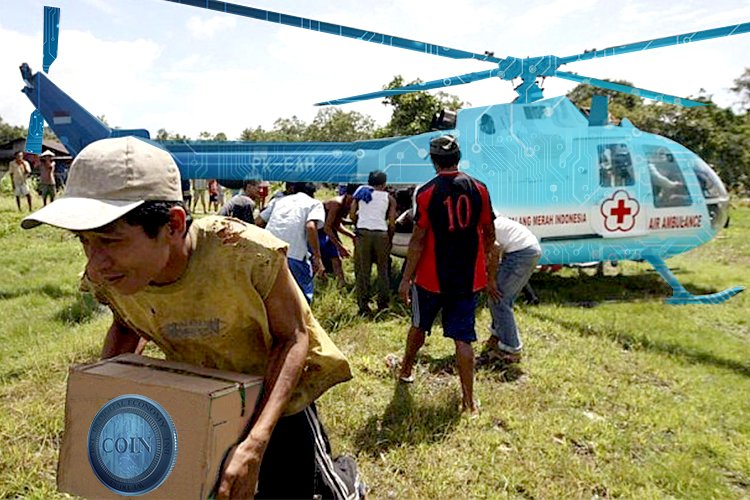Tragedy In Indonesia. How Humanitarian Supplies Being Embezzled

Over the past 20 years, 1.35 million people have died because of natural disasters; 4.4 billion were harmed. Natural disasters cost governments $2.9 trillion. And, according to UN statistics from 1998 to 2017, the extent of damage increased by 251%. At the same time, only the European Union spends more than €1 billion ($1.2 billion) on humanitarian needs per year. But how much money do people whose lives were intervened by nature really receive? And can this be traced?
The latest example is the earthquake in Indonesia. This country is considered an industrial giant, it is one of the world's industrial factories, and many goods are produced there, starting with Adidas sneakers and finishing with Washburn guitars. But here on Java, the main island of the Indonesian archipelago, there were three natural disasters in a row. More than 2,000 people were found dead and 5,000 are missing, tens of thousands were left homeless, the damage to the economy - tens of millions dollars. The excuses of the representatives of the competent authorities that such a number of victims was caused by the terrain feature do not look convincing.
Yes, in this region, on the islands of Java and Sulawesi, there is a problem of soil ramollissement, when, as a result of earth shocks, entire villages, in the truest sense of the word, fall under the ground. But this does not happen in a matter of minutes, a warning system and evacuation of residents from dangerous areas could work if it existed. Now, different countries of the world and humanitarian organizations allocate funds from their budgets to help the victims. The International Red Cross allocated $10 million, Great Britain sent $5.5 million, the European Union - €3 million ($3.47 million), the United States and Australia - $2.5 million each. And this is only the beginning. But how much money will really go to help people, or at least to create a system for preventing the consequences of natural disasters?
After all, humanitarian supplies are a very profitable business. For example, to help victims of the earthquake in Haiti in 2010, one of the most destructive in the history of mankind (222,570 dead!), International organizations allocated $948 per person. Only during the charity telethon, $57 million was collected to help the victims of the disaster. However, the information about how much of these funds actually reached the victims has not been disclosed yet. Over the 8 years that have passed since the day of the tragedy, the country's infrastructure has not been restored. Moreover, according to the calculations of journalists, during 2 years after the earthquake, $3.6 billion leaked away from the restoration budget.
The humanitarian sphere is not for romantics. Can digital technologies at the present stage of their development keep track of who really gets help? The answer is likely to be positive.
One of the attempts to respond to global challenges is the Call for Code program, implemented by the UN Human Rights Office, the US Red Cross, and IBM Company. More than $30 million over 5 years. It is planned to make investments in the creation of a warning system of disastrous consequences. On the basis of the distributed ledger technology, the developers want to create a safe and reliable structure for tracking funding and the delivery of humanitarian supplies to residents of the affected regions.
“We cannot control natural disasters yet, but we can minimize the damage by preventive measures and proper provision of assistance after any disaster, - Saif ALI, the developer of the user interface of Blockchain (Hyperledger) at IBM India Private Limited said, specifically for Bitnewstoday.com. - People donate money to help those affected by natural disasters. But currently, there is no efficient and transparent way to register these transactions. With the help of the blockchain, we can provide greater transparency and ensure that all the help and money will reach people affected by the disaster.”
“I understand that the blockchain may not help here, but it would be a good option for tracking supplies of humanitarian aid,” - our commentator, a highest-ranked IBM executive, who didn’t wish to be named, says.
We are lucky if it is so. But there is another circumstance that puts the effectiveness of the global humanitarian initiatives in question. Ambitions of superpowers, corruption — you can’t simply brush off these negative factors. I would like to believe that a new cross-border economy will become a cross-border policy one day. But this has not happened yet. Although the people who join the DLT chains every day want this very much.
Obviously, for the implementation of the projects to prevent the devastating effects of natural disasters and combat corruption schemes in humanitarian programs, the efforts of one country or company will not be enough. But the union of several countries in this matter is hardly possible. On the one hand, countries have lost their capacity to contract to a large extent due to the global growing geopolitical contradictions. On the other hand, hardly anyone will voluntarily give up such amounts of money for the sake of the well-being of strangers, even tens of thousands. Self comes first, and the blockchain's prospects in this sphere are too vague and far away. Most likely, when they come close, dishonest political elites will do everything possible to ensure that anti-corruption blockchain solutions are never brought to life.